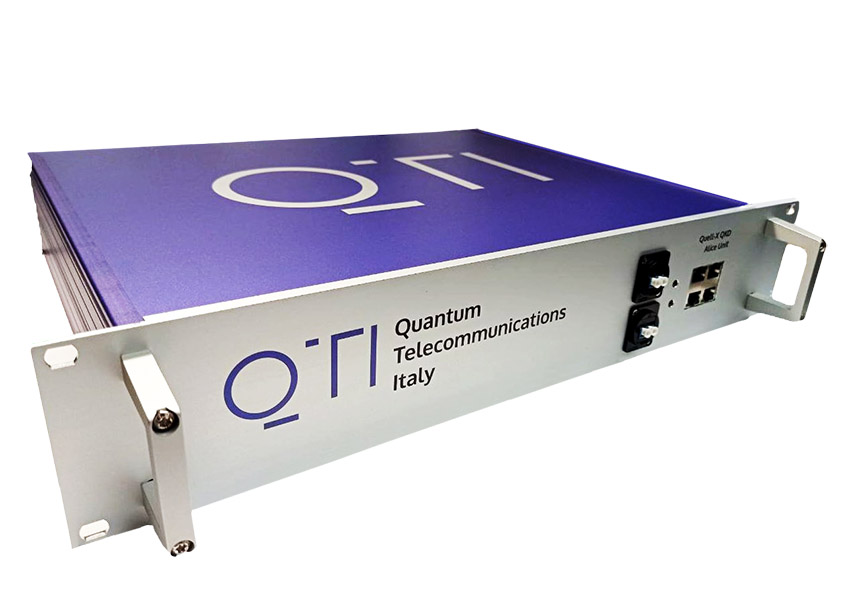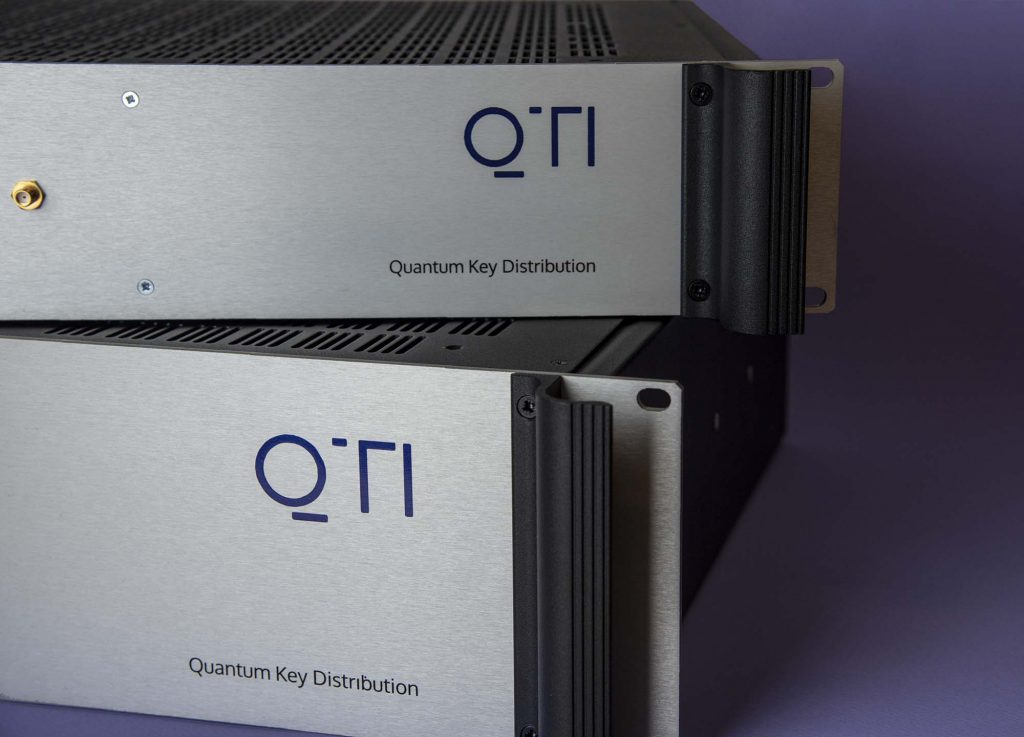QTI is the first Italian Quantum Key Distribution company, providing industrial grade systems and products for quantum networks. It is a young Italian start-up founded in October 2020 as a spin-off of the National Institute of Optics of the National Research Council (CNR). The company engineers, develops, and produces reconfigurable Quantum Key Distribution (QKD) architectures, offering fully made in Italy products and solutions, designed, and developed with proprietary skills and expertise using a strategic European supply chain. In 2021, Telsy, cybersecurity and cryptography competence center of the TIM Group, has invested in QTI shares.
QTI’s mission is to develop, produce and sell telecom ready QKD systems for industry, government, and military organizations. Customers equipped with its QKD solution can enjoy technological supremacy over competitors and ensure the highest security standard available on the market for transmission and storage of data.
Interview with Davide Bacco, CTO at QTI.
Easy Engineering: What are the main areas of activity of the company?
Davide Bacco: Born as a spin-off of the CNR, QTI combines a strong research background with strategic entrepreneurial spirit. It operated in the telecom market offering QKD systems for ultra-secure communications. The company is highly competitive in the field of QKD on ground fiber optics for telecommunication networks. However, it is also active in the domain of free space QKD for satellite systems and underwater quantum technologies. This rapid evolution is bringing the company to encompass all the operational domains in which QKD can be implemented, keeping up with the needs of all its customers from business, government, defence and military organizations, and academia.
E.E: What’s the news about new products?
D.B: QTI products have been developed and produced using the most up-to-date components, with a technology based on unique patented solutions and a strategic European supply chain. Thanks to the strategic partnership with Telsy, the company is on the market with a leading-edge system integrating its QKD systems with Telsy’s hardware cipher units, providing a complete solution for ultra-secure communications.
The application sectors of QTI products include data center security; medical data protection; national and cross-borders backbones; governmental and financial data security; and critical infrastructure security, e.g. airports, harbors, gas distribution, and power-grids distribution.

E.E: What are the ranges of products?
D.B: QTI’s flagship is the Quell-X, a family of products encompassing various configurations of QKD systems. Quell-X is a complete QKD system able to generate symmetric secured keys for ultra-secure data communication in current infrastructures.
Quell-X family is composed by three main versions:
Quell-X, the core product of family. It ensures a reliable and high-performance QKD quantum key generation. It includes the standardized key management entity and is compatible with third parties’ encryptor unit.
Quell-XC, the end-to-end encryption system based on Quell-X core. The product includes in a fully integrated solution high-speed cyphers units (from Telsy s.p.a.) injected with the quantum keys generated by our QKD system.
Quell-XR, the Quell-X version for academic and research activities. It generates raw key data for custom post-processing protocols and future developments. Quell-XR is a platform open for customization and can be interfaces with third parties’ detectors.
E.E: At what stage is the market where you are currently active?
D.B: The QKD market is included in two larger market sets, the telecom segment and that of quantum technologies. The global telecom market is currently well-developed all over the globe. The more specific segment of communications security, that encompasses both cybersecurity and cryptography, is also remarkably advanced. Classical cryptography is currently still more present on the market compared to QKD. The quantum technologies market actually encompasses two main components: quantum communications and quantum computing.
Quantum communications includes the technologies necessary to allow quantum computers to communicate between each other and Quantum Key Distribution technologies.
Dealing more specifically with the latter, this technology is relatively recent considering that the first QKD protocol, the BB84, has been introduced only in 1984, with the first prototype QKD system built four years later. In a few decades, QKD has raised global interest due to its unique features. Research and development remains a key component of QKD market, while an increasing number of companies is investing in this market sector. In recent years, the Covid-19 pandemic and the increased reliance on remote services and data exchange has raised the awareness of the vulnerability of current infrastructures and the paramount value of information security, generating a QKD market expansion. A further driver for the QKD market is the expectation of the spread use of quantum computers, that are capable of breaching the security based on classical cryptography algorithms. QKD secures communications also against the threat of the store & decrypt later, i.e. when attackers steal sensitive data and keep it with the intent of decrypting it once quantum computing becomes available.
E.E: What can you tell us about market trends?
D.B: The increase in connected devices is a driving factor for the QKD market. According to a recent report by the World Economic Forum, State of the Connected World (2020), it is expected that around 41.6 billion devices will be capturing data by 2025. Smart grids, smart cities, and connected critical infrastructures generate the need for ultra-secure communications, while the number of cyberattacks and data exfiltration is raising. According to recent estimates, encryption is the first choice to protect data on the cloud for 59% of survey respondents. However, only 50% affirmed that more than 40% of their sensitive data in the cloud has been encrypted (2022 Thales Data Threat Report).
In this framework, the global QKD market is expected to reach USD 4604.1 million by 2027, from USD 1106 million in 2020, at a CAGR of 21.5% during 2021-2027 (Global Quantum Cryptography Market Forecast, 2022).
Providers of QKD systems are experiencing new business opportunities. To gain a strategic position on the market, they often foster partnerships, strategic collaborations, and mergers with other companies. This is exactly what QTI experiences with its partnership with Telsy (cryptography competence center) and its link to the TIM Group, the most important Italian telecom provider, with a well-established fiber network covering all the country.

Further, the market is also stimulated by public investments set by national governments. In Italy, the National Research Program 2021-2027 encompasses quantum technologies among key components in the “Digital, industry and aerospace” field, considering them as high level investment priorities. Then at regional level, the European Union is massively operating for bolstering QKD market, financing several related projects, such as the EU Quantum Flagship and EuroQCI. The European Space Agency is also acting in this direction for a spread use of free space QKD.
E.E: What are the most innovative products marketed?
D.B: Currently there is a growing number of QKD providers on the market, with a level of commercial success depending on their ability to provide up-to-date and innovative solutions. The inclusion of QTI in the business of Telsy and the TIM Group testifies that we are capable of offering effective responses to the challenges of the telecom market, based on our leading-edge products. We have found innovative solutions for QKD implementations in existing networks. In this sense, QTI has been the first company to implement a demonstration of an intergovernmental quantum communication between three Countries – Italy, Slovenia and Croatia during the 2021 G20. This capability is a key factor, considering that the spread of the use of QKD all over Europe is one of the major goals of technological development plans of the EU and European countries.
E.E: What estimations do you have for 2022?
D.B: In the next couple of years, EU and national projects will act as major drivers for the QKD market, coupled with an increasing number of early adopters of QKD technologies among institutions and large companies. Further developments and larger market expansion are then expected in the medium term. As per the current fiscal year, QTI has achieved great results in the Italian and European market.

